Inhomogeneous Microstructure Evolution of 6061 Aluminum Alloyat High Rotating Speed Submerged Friction Stir Processing
Abstract
1. Introduction
2. Materials and Experimental Setup
2.1. Material Preparation
2.2. The Microstructure and Mechanical Properties Analysis
3. Results
3.1. Processing Thermal Cycle Curve
3.2. Mechanical Property
3.3. EBSD Analysis
3.3.1. Grain Size and Misorientation Angle Distribution Statistics
3.3.2. Qualitative and Quantitative Statistics of Texture
3.3.3. Dislocation Distribution in Grain-Based and Kernel-Based Level
3.3.4. Processing Boundary Analysis
3.3.5. Further Analysis of SZ-2 Microstructure
3.4. TEM Analysis
4. Discussion
4.1. Microstructure Evolution in the Processing Zone
4.2. The Mechanism of Strengthen
4.2.1. Grain Boundary Strengthening
4.2.2. Dislocation Strengthening
4.2.3. Precipitation Phase Strengthening
4.2.4. Solid Solution Strengthening
4.3. The Synergy of Strength and Ductility
5. Conclusions
- HRS-SFSP processing zone shows excellent mechanical properties and overcomes the contradiction between strength and ductility. The strength and ductility of 6061 aluminum alloy are increased by 48.7% and 10.2% respectively compared with BM. This was credited to the plastic–elastic interface generated by the inhomogeneous structure in the processing zone.
- The plastic–elastic interface is composed of deformed grains and recrystallized grains. Deformed grains produce dislocation gradients by affecting the distribution of dislocations and promote the initiation of more slip systems. Meanwhile, the recrystallization proportions in SZ-1, SZ-2 and SZ-3 are 14.3%, 37.8% and 35.9% respectively, which provide sufficient plasticity for aluminum alloy. These can facilitate strain hardening and improved ductility and are composed of deformed grains and recrystallized grains. Deformed grains produce dislocation gradients by affecting the distribution of dislocations and promote the initiation of more slip systems. Meanwhile, the recrystallization proportions in SZ-1, SZ-2 and SZ-3 are 14.3%, 37.8% and 35.9% respectively, which provide sufficient plasticity for aluminum alloy. These can facilitate strain hardening and improved ductility.
- The recrystallization mechanism at different locations in the processing zone is different. GDRX and CDRX are dominant in SZ-1 and SZ-3, while CDRX and DDRX are dominant in SZ-2. The transformation of recrystallization mechanism is also an important factor affecting the evolution of microstructures.
- The difference of mechanical properties in the processing zone comes from the difference of grain size, dislocation density, second phase distribution and solid solubility. The grain boundary strengthening and the second phase strengthening are the main ones. Meanwhile, the uniformly distributed and fine second phase promotes the plastic–elastic interface effect.
- HRS-SFSP is a modified version of FSP. Although the use of small size tools may affect the processing efficiency, the mechanical properties of aluminum alloys are significantly improved. Therefore, it is recommended to apply it in industry.
Author Contributions
Funding
Institutional Review Board Statement
Informed Consent Statement
Data Availability Statement
Acknowledgments
Conflicts of Interest
References
- Abbasi, M.; Givi, M.; Bagheri, B. New method to enhance the mechanical characteristics of Al-5052 alloy weldment produced by tungsten inert gas. Proc. Inst. Mech. Eng. Part B J. Eng. Manuf. 2020, 1–9. [Google Scholar] [CrossRef]
- Mao, D.; Meng, X.; Xie, Y.; Yang, Y.; Xu, Y.; Qin, Z.; Chang, Y.; Wan, L.; Huang, Y. Strength-ductility balance strategy in SiC reinforced aluminum matrix composites via deformation-driven metallurgy. J. Alloys Compd. 2022, 891, 162078. [Google Scholar] [CrossRef]
- Moradi, M.; Nili-Ahmadabadi, M.; Poorganji, B.; Heidarian, B.; Parsa, M.; Furuhara, T. Recrystallization behavior of ECAPed A356 alloy at semi-solid reheating temperature. Mater. Sci. Eng. A 2010, 527, 4113–4121. [Google Scholar] [CrossRef]
- Ashouri, S.; Nili-Ahmadabadi, M.; Moradi, M.; Iranpour, M. Semi-solid microstructure evolution during reheating of aluminum A356 alloy deformed severely by ECAP. J. Alloys Compd. 2008, 466, 67–72. [Google Scholar] [CrossRef]
- Donatus, U.; Thompson, G.; Momoh, M.; Maledi, N.; Tsai, I.-L.; Ferreira, R.O.; Liu, Z. Variations in stir zone and thermomechanically affected zone of dissimilar friction stir weld of AA5083 and AA6082 alloys. Trans. Nonferrous Met. Soc. China 2018, 28, 2410–2418. [Google Scholar] [CrossRef]
- Shen, Z.; Ding, Y.; Chen, J.; Amirkhiz, B.S.; Wen, J.; Fu, L.; Gerlich, A. Interfacial bonding mechanism in Al/coated steel dissimilar refill friction stir spot welds. J. Mater. Sci. Technol. 2019, 35, 1027–1038. [Google Scholar] [CrossRef]
- Zhang, Y.; Jiang, J.; Wang, Y.; Xiao, G.; Liu, Y.; Huang, M. Recrystallization process of hot-extruded 6A02 aluminum alloy in solid and semi-solid temperature ranges. J. Alloys Compd. 2021, 893, 162311. [Google Scholar] [CrossRef]
- Mishra, R.; Mahoney, M.; McFadden, S.; Mara, N.; Mukherjee, A. High strain rate superplasticity in a friction stir processed 7075 Al alloy. Scr. Mater. 1999, 42, 163–168. [Google Scholar] [CrossRef]
- Peng, Y.; Zhang, Q.; Wen, L.; Xie, Z.; Huang, B.; Hu, S.; Tang, H.; Wei, C. An Investigation into Microstructures and Mechanical Properties of 1060 Pure Aluminum during Submerged Friction Stir Processing at a High Rotating Speed. Metals 2022, 12, 201. [Google Scholar] [CrossRef]
- Li, J.; Zhao, M.; Jin, L.; Wang, F.; Dong, S.; Dong, J. Simultaneously improving strength and ductility through laminate structure design in Mg–8.0Gd–3.0Y-0.5Zr alloys. J. Mater. Sci. Technol. 2021, 71, 195–200. [Google Scholar] [CrossRef]
- Han, M.-S.; Lee, S.-J.; Park, J.-C.; Ko, S.-C.; Woo, Y.-B.; Kim, S.-J. Optimum condition by mechanical characteristic evaluation in friction stir welding for 5083-O Al alloy. Trans. Nonferrous Met. Soc. China 2009, 19, s17–s22. [Google Scholar] [CrossRef]
- Sharma, D.K.; Badheka, V.J.; Patel, V.; Upadhyay, G. Recent Developments in Hybrid Surface Metal Matrix Composites Produced by Friction Stir Processing: A Review. J. Tribol. 2021, 143, 050801. [Google Scholar] [CrossRef]
- Zhang, H.J.; Wang, M.; Zhu, Z.; Zhang, X.; Yu, T.; Wu, Z.Q. Nugget Structure Evolution with Rotation Speed for High-Rotation-Speed Friction-Stir-Welded 6061 Aluminum Alloy. J. Mater. Eng. Perform. 2018, 27, 1378–1386. [Google Scholar] [CrossRef]
- Abdollahzadeh, A.; Bagheri, B.; Abassi, M.; Kokabi, A.H.; Moghaddam, A.O. Comparison of the Weldability of AA6061-T6 Joint under Different Friction Stir Welding Conditions. J. Mater. Eng. Perform. 2021, 30, 1110–1127. [Google Scholar] [CrossRef]
- Lin, P.-T.; Liu, H.-C.; Hsieh, P.-Y.; Wei, C.-Y.; Tsai, C.-W.; Sato, Y.S.; Chen, S.-C.; Yen, H.-W.; Lu, N.-H.; Chen, C.-H. Heterogeneous structure-induced strength-ductility synergy by partial recrystallization during friction stir welding of a high-entropy alloy. Mater. Des. 2021, 197, 109238. [Google Scholar] [CrossRef]
- Chen, J.; Bao, C.; Ma, Y.; Chen, Z. Distribution control of AlN particles in Mg-Al/AlN composites. J. Alloys Compd. 2017, 695, 162–170. [Google Scholar] [CrossRef]
- Xie, Y.; Meng, X.; Mao, D.; Qin, Z.; Wan, L.; Huang, Y. Homogeneously Dispersed Graphene Nanoplatelets as Long-Term Corrosion Inhibitors for Aluminum Matrix Composites. ACS Appl. Mater. Interfaces 2021, 13, 32161–32174. [Google Scholar] [CrossRef]
- Guru, P.; Khan, F.; Panigrahi, S.; Ram, G.J. Enhancing strength, ductility and machinability of a Al–Si cast alloy by friction stir processing. J. Manuf. Process. 2015, 18, 67–74. [Google Scholar] [CrossRef]
- Jiang, H.; Liu, C.; Zhang, B.; Xue, P.; Ma, Z.; Luo, K.; Ma, M.; Liu, R. Simultaneously improving mechanical properties and damping capacity of Al-Mg-Si alloy through friction stir processing. Mater. Charact. 2017, 131, 425–430. [Google Scholar] [CrossRef]
- Lambiase, F.; Derazkola, H.A.; Simchi, A. Friction Stir Welding and Friction Spot Stir Welding Processes of Polymers—State of the Art. Materials 2020, 13, 2291. [Google Scholar] [CrossRef]
- Mohamed, I.F.; Lee, S.; Edalati, K.; Horita, Z.; Hirosawa, S.; Matsuda, K.; Terada, D. Aging Behavior of Al 6061 Alloy Processed by High-Pressure Torsion and Subsequent Aging. Met. Mater. Trans. A 2015, 46, 2664–2673. [Google Scholar] [CrossRef]
- Khalaf, H.I.; Al-Sabur, R.; Abdullah, M.E.; Kubit, A.; Derazkola, H.A. Effects of Underwater Friction Stir Welding Heat Generation on Residual Stress of AA6068-T6 Aluminum Alloy. Materials 2022, 15, 2223. [Google Scholar] [CrossRef] [PubMed]
- Tamjidy, M.; Baharudin, B.T.H.T.; Paslar, S.; Matori, K.A.; Sulaiman, S.; Fadaeifard, F. Multi-Objective Optimization of Friction Stir Welding Process Parameters of AA6061-T6 and AA7075-T6 Using a Biogeography Based Optimization Algorithm. Materials 2017, 10, 533. [Google Scholar] [CrossRef] [PubMed]
- Seo, P.; Kang, C. The effect of raw material fabrication process on microstructural characteristics in reheating process for semi-solid forming. J. Mater. Process. Technol. 2005, 162, 402–409. [Google Scholar] [CrossRef]
- Liu, X.-C.; Zhen, Y.-Q.; Sun, Y.-F.; Shen, Z.-K.; Chen, H.-Y.; Guo, W.; Li, W.-Y. Local inhomogeneity of mechanical properties in stir zone of friction stir welded AA1050 aluminum alloy. Trans. Nonferrous Met. Soc. China 2020, 30, 2369–2380. [Google Scholar] [CrossRef]
- Çam, G.; Yeni, Ç.; Erim, S.; Ventzke, V.; Koçak, M. Investigation into properties of laser welded similar and dissimilar steel joints. Sci. Technol. Weld. Join. 1998, 3, 177–189. [Google Scholar] [CrossRef]
- Yi, D.; Mironov, S.; Sato, Y.S.; Kokawa, H. Effect of cooling rate on microstructure of friction-stir welded AA1100 aluminum alloy. Philos. Mag. 2016, 96, 1965–1977. [Google Scholar] [CrossRef]
- Chen, Y.; Jiang, Y.; Zhang, F.; Ding, H.; Zhao, J.; Ren, Z. Water Cooling Effects on the Microstructural Evolution and Mechanical Properties of Friction-Stir-Processed Al-6061 Alloy. Trans. Indian Inst. Met. 2018, 71, 3077–3087. [Google Scholar] [CrossRef]
- Chang, S.-Y.; Lee, K.-S.; Choi, S.-H.; Shin, D.H. Effect of ECAP on microstructure and mechanical properties of a commercial 6061 Al alloy produced by powder metallurgy. J. Alloys Compd. 2003, 354, 216–220. [Google Scholar] [CrossRef]
- Ji, S.D.; Meng, X.C.; Ma, L.; Gao, S.S. Effect of groove distribution in shoulder on formation, macrostructures, and mechanical properties of pinless friction stir welding of 6061-O aluminum alloy. Int. J. Adv. Manuf. Technol. 2016, 87, 3051–3058. [Google Scholar] [CrossRef]
- Doherty, R.; Kashyap, K.; Panchanadeeswaran, S. Direct observation of the development of recrystallization texture in commercial purity aluminum. Acta Met. Mater. 1993, 41, 3029–3053. [Google Scholar] [CrossRef]
- Mitsche, S.; Poelt, P.; Sommitsch, C. Recrystallization behaviour of the nickel-based alloy 80 A during hot forming. J. Microsc. 2007, 227, 267–274. [Google Scholar] [CrossRef]
- Jiang, J.-F.; Wang, Y.; Liu, Y.-Z.; Xiao, G.-F.; Li, H. Microstructure and mechanical properties of 7005 aluminum alloy processed by one-pass equal channel reciprocating extrusion. Trans. Nonferrous Met. Soc. China 2021, 31, 609–625. [Google Scholar] [CrossRef]
- Gussev, M.; Leonard, K. In situ SEM-EBSD analysis of plastic deformation mechanisms in neutron-irradiated austenitic steel. J. Nucl. Mater. 2019, 517, 45–56. [Google Scholar] [CrossRef]
- Shen, R.R.; Ström, V.; Efsing, P. Spatial correlation between local misorientations and nanoindentation hardness in nickel-base alloy 690. Mater. Sci. Eng. A 2016, 674, 171–177. [Google Scholar] [CrossRef]
- Jiang, S.; Jia, Y.; Wang, X. In-situ analysis of slip transfer and heterogeneous deformation in tension of Mg-5.4Gd-1.8Y-1.5Zn alloy. J. Magnes. Alloys 2020, 8, 1186–1197. [Google Scholar] [CrossRef]
- Sakai, T.; Miura, H.; Goloborodko, A.; Sitdikov, O. Continuous dynamic recrystallization during the transient severe deformation of aluminum alloy 7475. Acta Mater. 2009, 57, 153–162. [Google Scholar] [CrossRef]
- Heidarzadeh, A.; Chabok, A.; Pei, Y. Friction stir welding of Monel alloy at different heat input conditions: Microstructural mechanisms and tensile behavior. Mater. Lett. 2019, 245, 94–97. [Google Scholar] [CrossRef]
- Xie, B.; Zhang, B.; Ning, Y.; Fu, M. Mechanisms of DRX nucleation with grain boundary bulging and subgrain rotation during the hot working of nickel-based superalloys with columnar grains. J. Alloys Compd. 2019, 786, 636–647. [Google Scholar] [CrossRef]
- Zhang, Y.; Jiang, S.; Wang, S.; Sun, D.; Hu, L. Influence of partial static recrystallization on microstructures and mechanical properties of NiTiFe shape memory alloy subjected to severe plastic deformation. Mater. Res. Bull. 2017, 88, 226–233. [Google Scholar] [CrossRef]
- Sauvage, X.; Bobruk, E.; Murashkin, M.; Nasedkina, Y.; Enikeev, N.; Valiev, R. Optimization of electrical conductivity and strength combination by structure design at the nanoscale in Al–Mg–Si alloys. Acta Mater. 2015, 98, 355–366. [Google Scholar] [CrossRef]
- Sato, Y.S.; Kokawa, H.; Enomoto, M.; Jogan, S. Microstructural evolution of 6063 aluminum during friction-stir welding. Met. Mater. Trans. A 1999, 30, 2429–2437. [Google Scholar] [CrossRef]
- Bagheri, B.; Alizadeh, M.; Mirsalehi, S.E.; Shamsipur, A.; Abdollahzadeh, A. Nanoparticles Addition in AA2024 Aluminum/Pure Copper Plate: FSSW Approach, Microstructure Evolution, Texture Study, and Mechanical Properties. Jom 2022, 74, 4420–4433. [Google Scholar] [CrossRef]
- Huang, K.; Logé, R. A review of dynamic recrystallization phenomena in metallic materials. Mater. Des. 2016, 111, 548–574. [Google Scholar] [CrossRef]
- Yu, P.; Wu, C.; Shi, L. Analysis and characterization of dynamic recrystallization and grain structure evolution in friction stir welding of aluminum plates. Acta Mater. 2021, 207, 116692. [Google Scholar] [CrossRef]
- Kamikawa, N.; Huang, X.; Tsuji, N.; Hansen, N. Strengthening mechanisms in nanostructured high-purity aluminium deformed to high strain and annealed. Acta Mater. 2009, 57, 4198–4208. [Google Scholar] [CrossRef]
- Yu, C.; Kao, P.; Chang, C. Transition of tensile deformation behaviors in ultrafine-grained aluminum. Acta Mater. 2005, 53, 4019–4028. [Google Scholar] [CrossRef]
- Hansen, N.; Huang, X. Microstructure and flow stress of polycrystals and single crystals. Acta Mater. 1998, 46, 1827–1836. [Google Scholar] [CrossRef]
- Xie, M.; Huan, Q.; Li, F. Quick and repeatable shear modulus measurement based on torsional resonance using a piezoelectric torsional transducer. Ultrasonics 2020, 103, 106101. [Google Scholar] [CrossRef]
- Yan, Z.; Wang, D.; He, X.; Wang, W.; Zhang, H.; Dong, P.; Li, C.; Li, Y.; Zhou, J.; Liu, Z.; et al. Deformation behaviors and cyclic strength assessment of AZ31B magnesium alloy based on steady ratcheting effect. Mater. Sci. Eng. A 2018, 723, 212–220. [Google Scholar] [CrossRef]
- Mi, Y.; Nie, H.; Wang, T.; Li, X.; Hao, X.; Liang, W. Effect of Anisotropy on Microstructures and Mechanical Properties of Rolled Ti/Al/Mg/Al/Ti Laminates. J. Mater. Eng. Perform. 2019, 28, 4143–4151. [Google Scholar] [CrossRef]
- Starink, M.; Wang, S. A model for the yield strength of overaged Al–Zn–Mg–Cu alloys. Acta Mater. 2003, 51, 5131–5150. [Google Scholar] [CrossRef]
- Bardel, D.; Perez, M.; Nelias, D.; Deschamps, A.; Hutchinson, C.; Maisonnette, D.; Chaise, T.; Garnier, J.; Bourlier, F. Coupled precipitation and yield strength modelling for non-isothermal treatments of a 6061 aluminium alloy. Acta Mater. 2013, 62, 129–140. [Google Scholar] [CrossRef]
- Myhr, O.R.; Grong, Ø.; Andersen, S.J. Modelling of the age hardening behaviour of Al–Mg–Si alloys. Acta Mater. 2001, 49, 65–75. [Google Scholar] [CrossRef]
- Zeng, X.; Xue, P.; Wu, L.; Ni, D.; Xiao, B.; Ma, Z. Achieving an ultra-high strength in a low alloyed Al alloy via a special structural design. Mater. Sci. Eng. A 2019, 755, 28–36. [Google Scholar] [CrossRef]
- Wu, X.; Jiang, P.; Chen, L.; Yuan, F.; Zhu, Y.T. Extraordinary strain hardening by gradient structure. Proc. Natl. Acad. Sci. USA 2014, 111, 7197–7201. [Google Scholar] [CrossRef]
- Wu, X.L.; Jiang, P.; Chen, L.; Zhang, J.F.; Yuan, F.P.; Zhu, Y.T. Synergetic Strengthening by Gradient Structure. Mater. Res. Lett. 2014, 2, 185–191. [Google Scholar] [CrossRef]
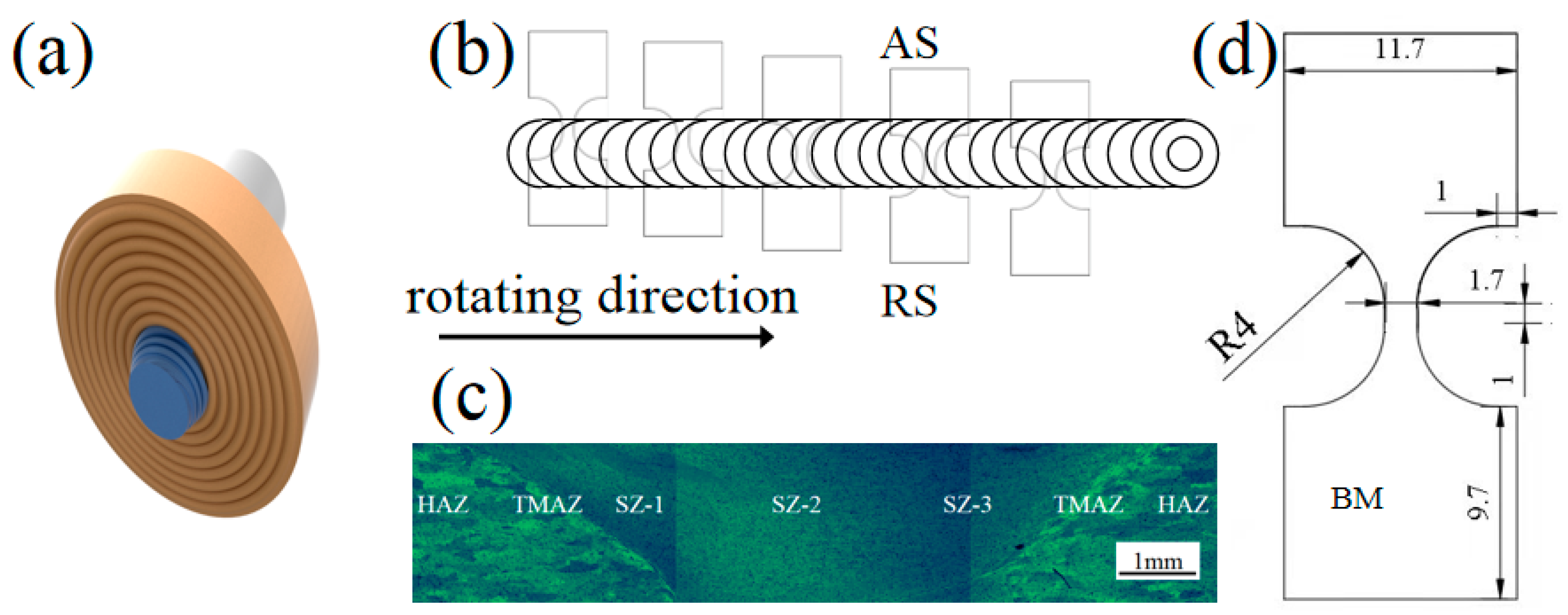
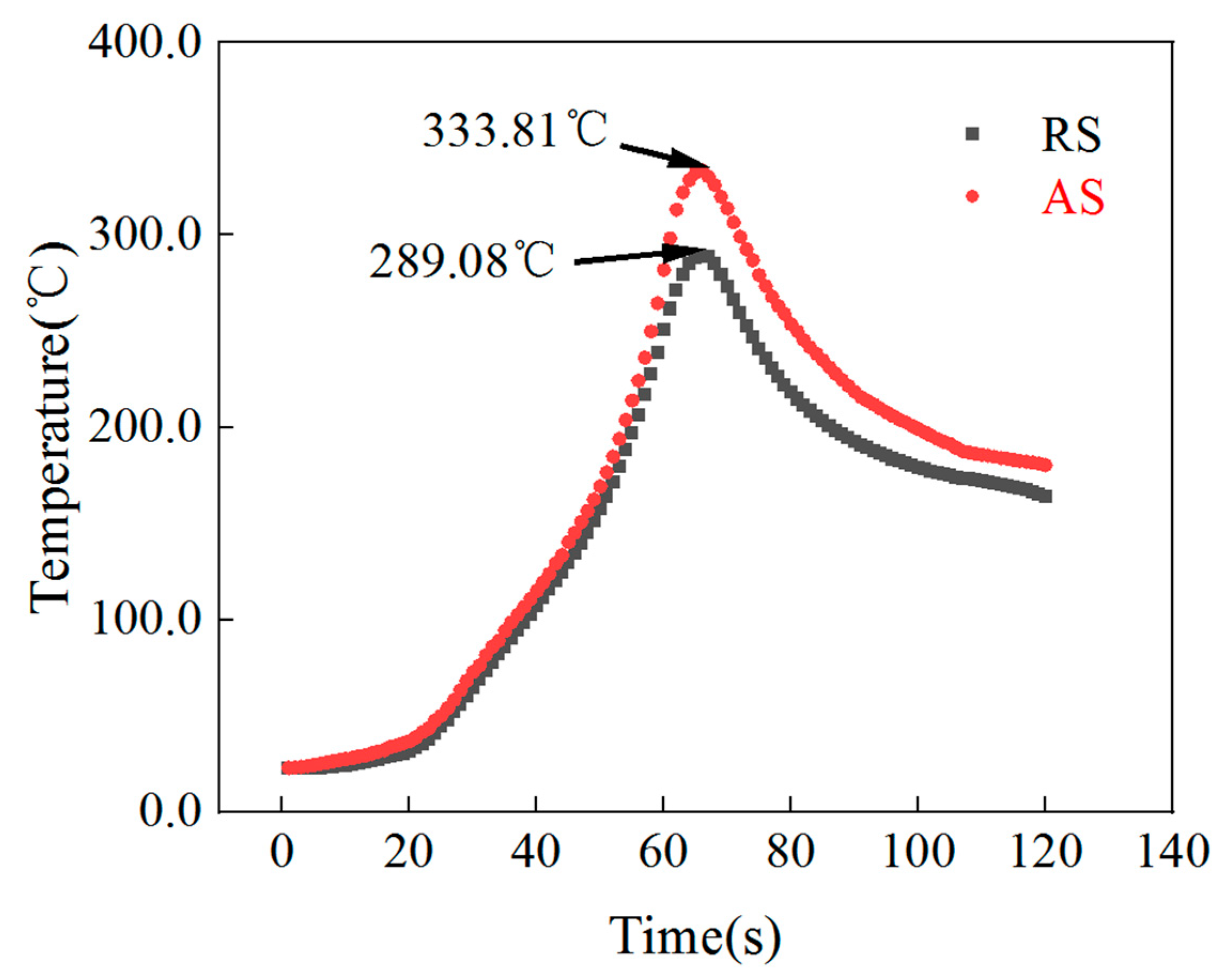
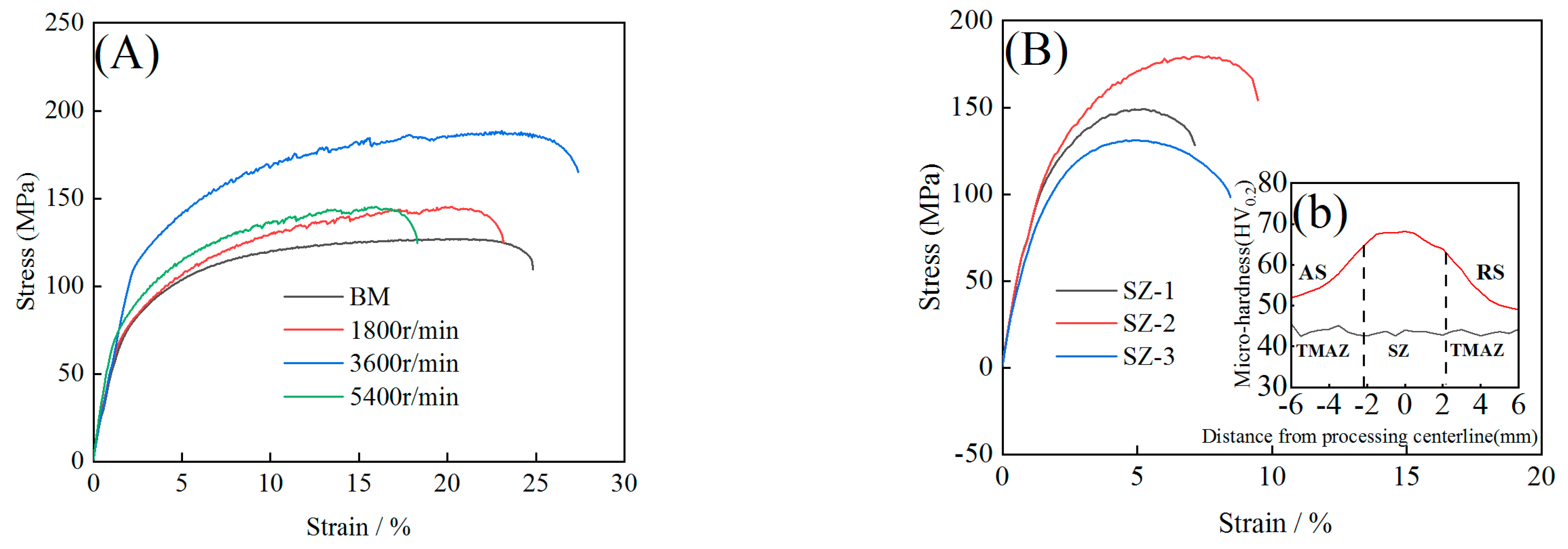
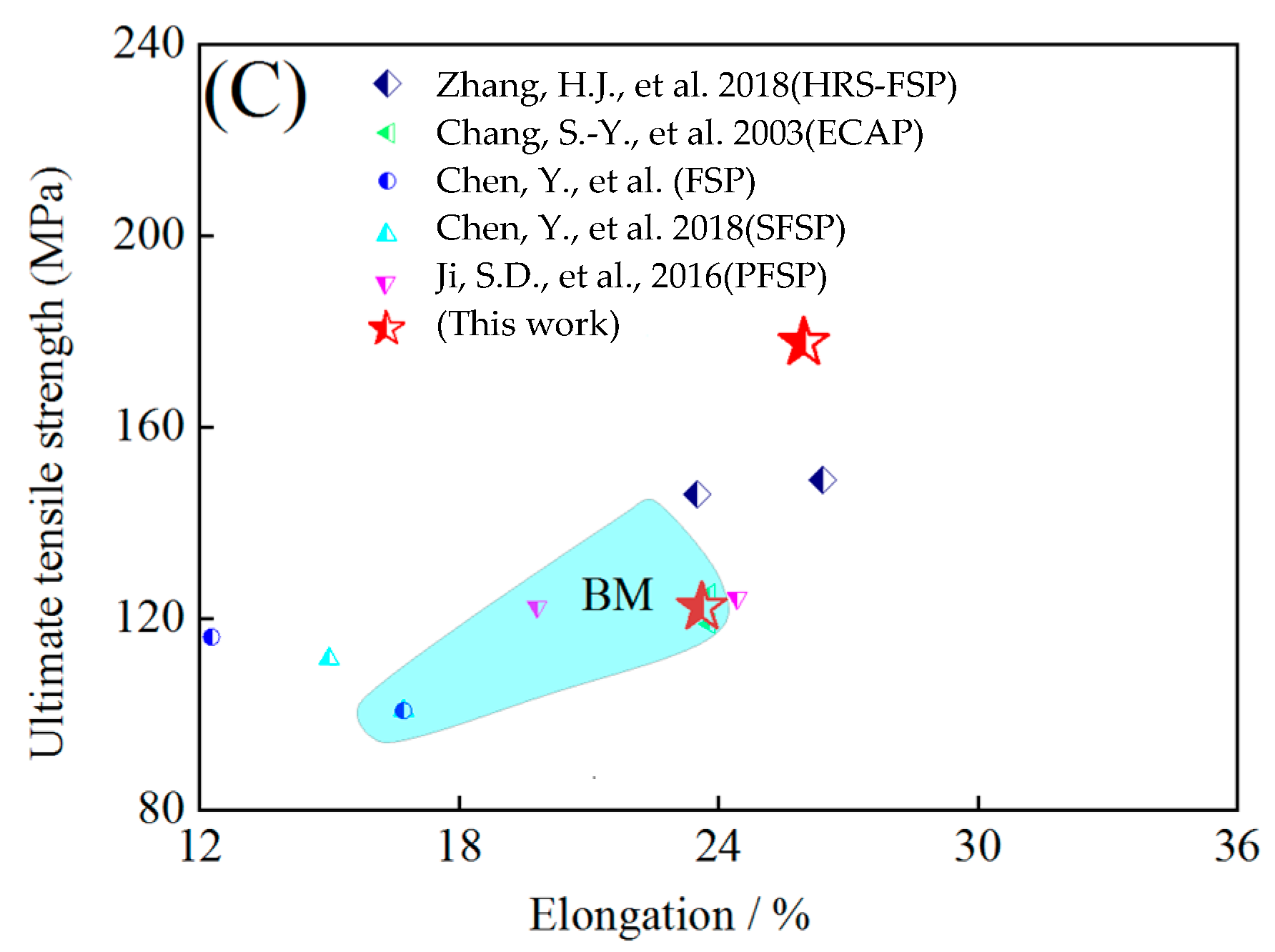
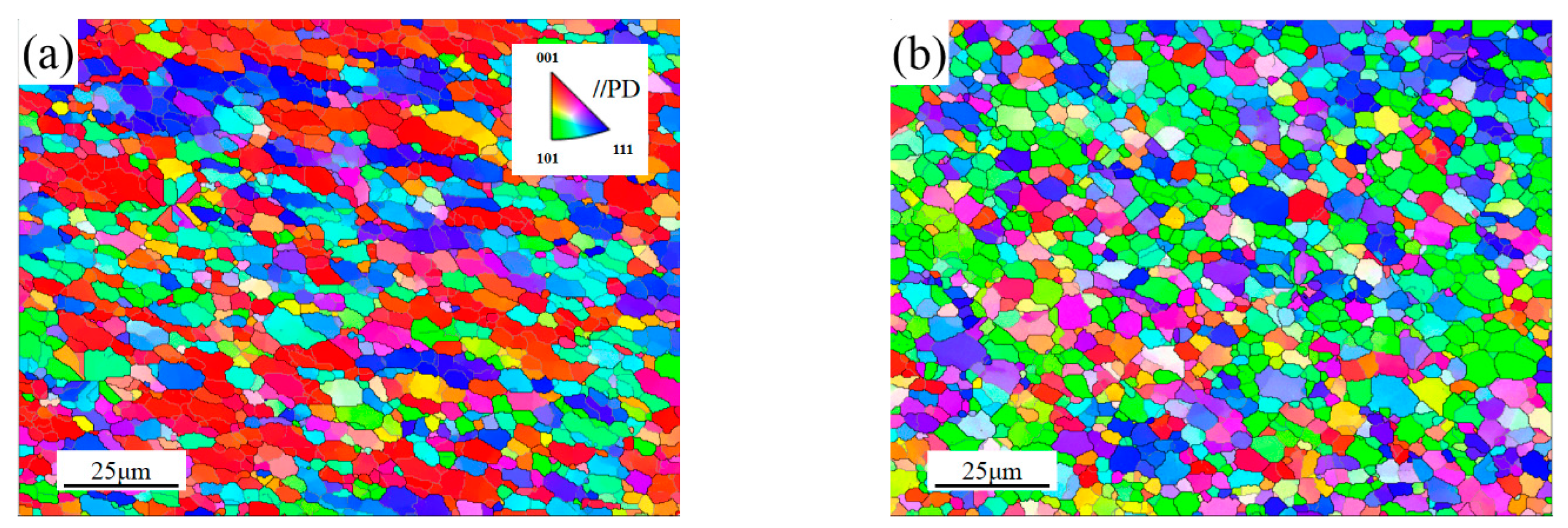

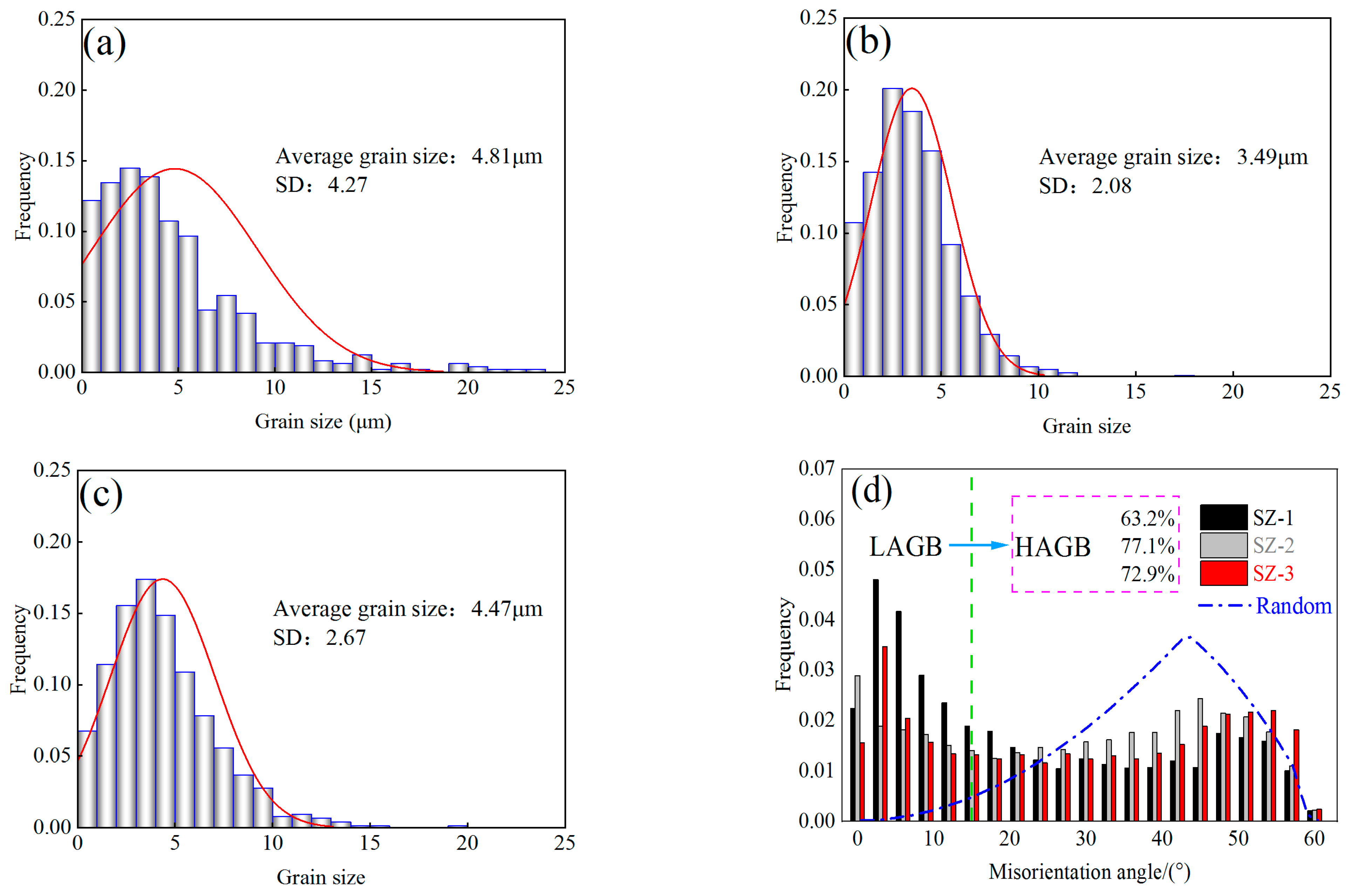
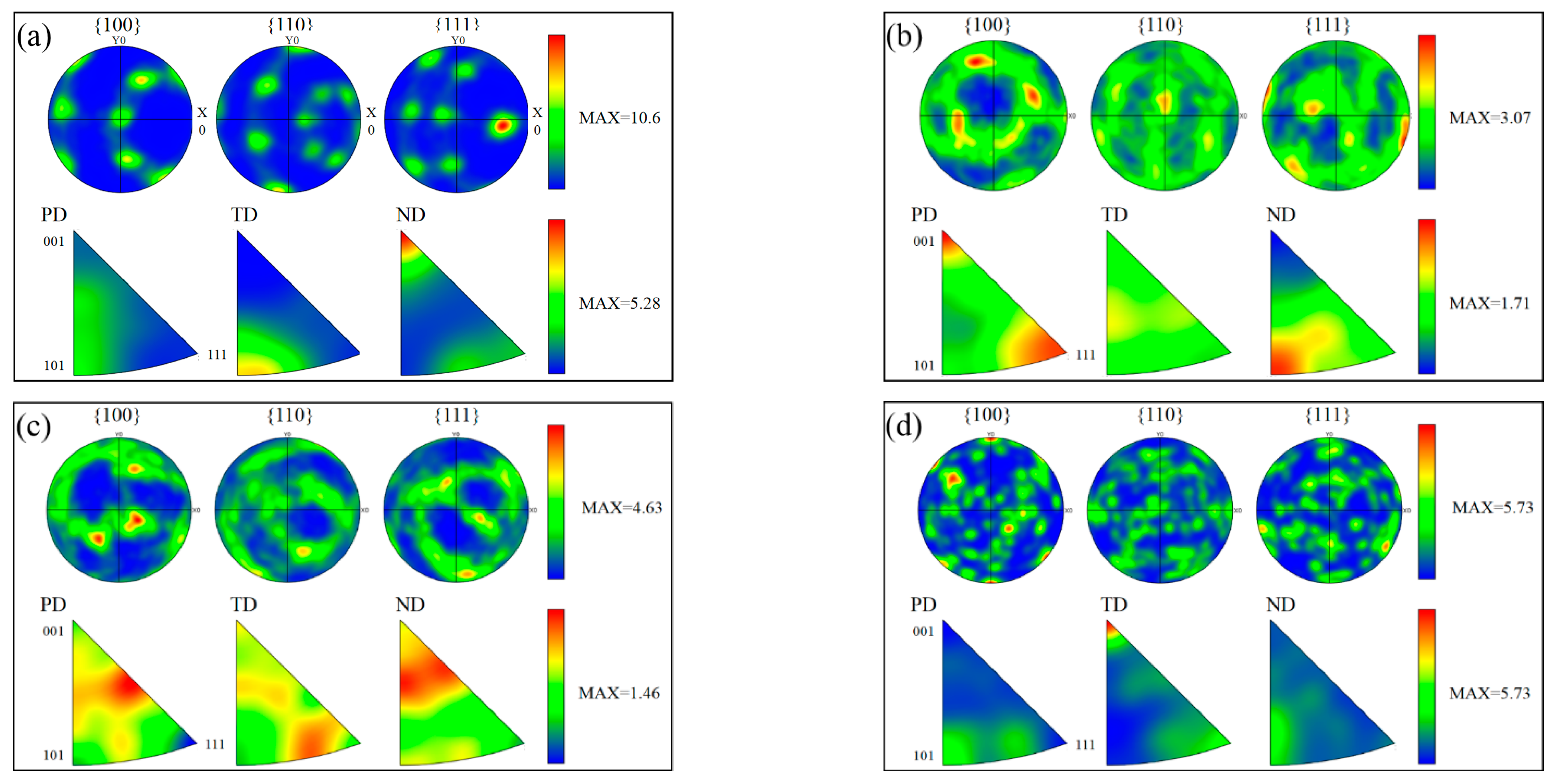


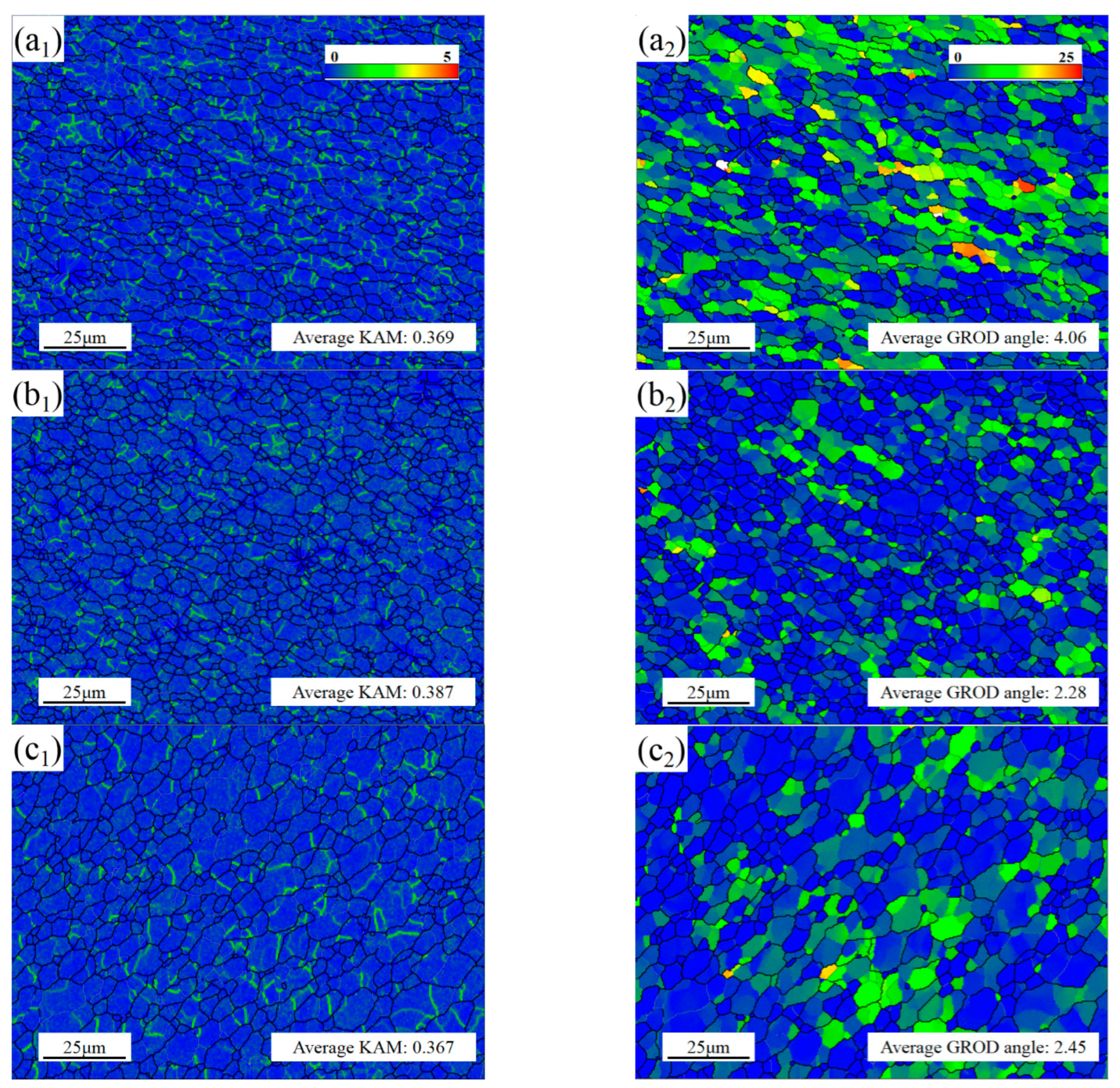
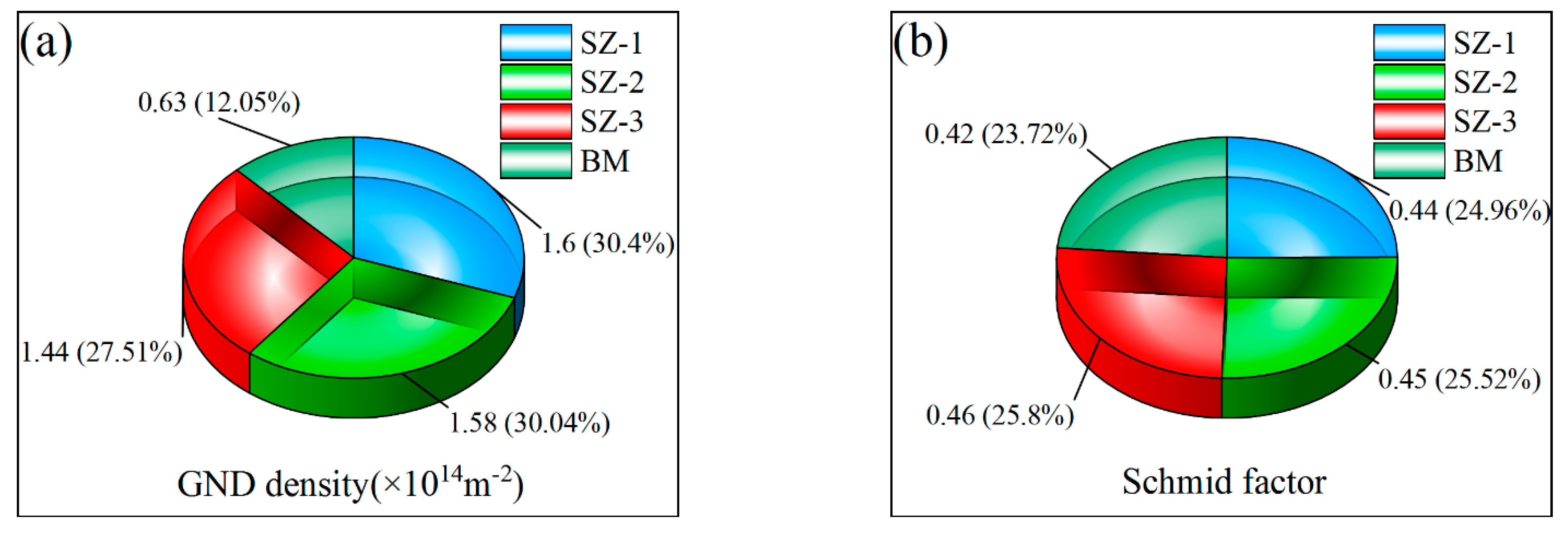

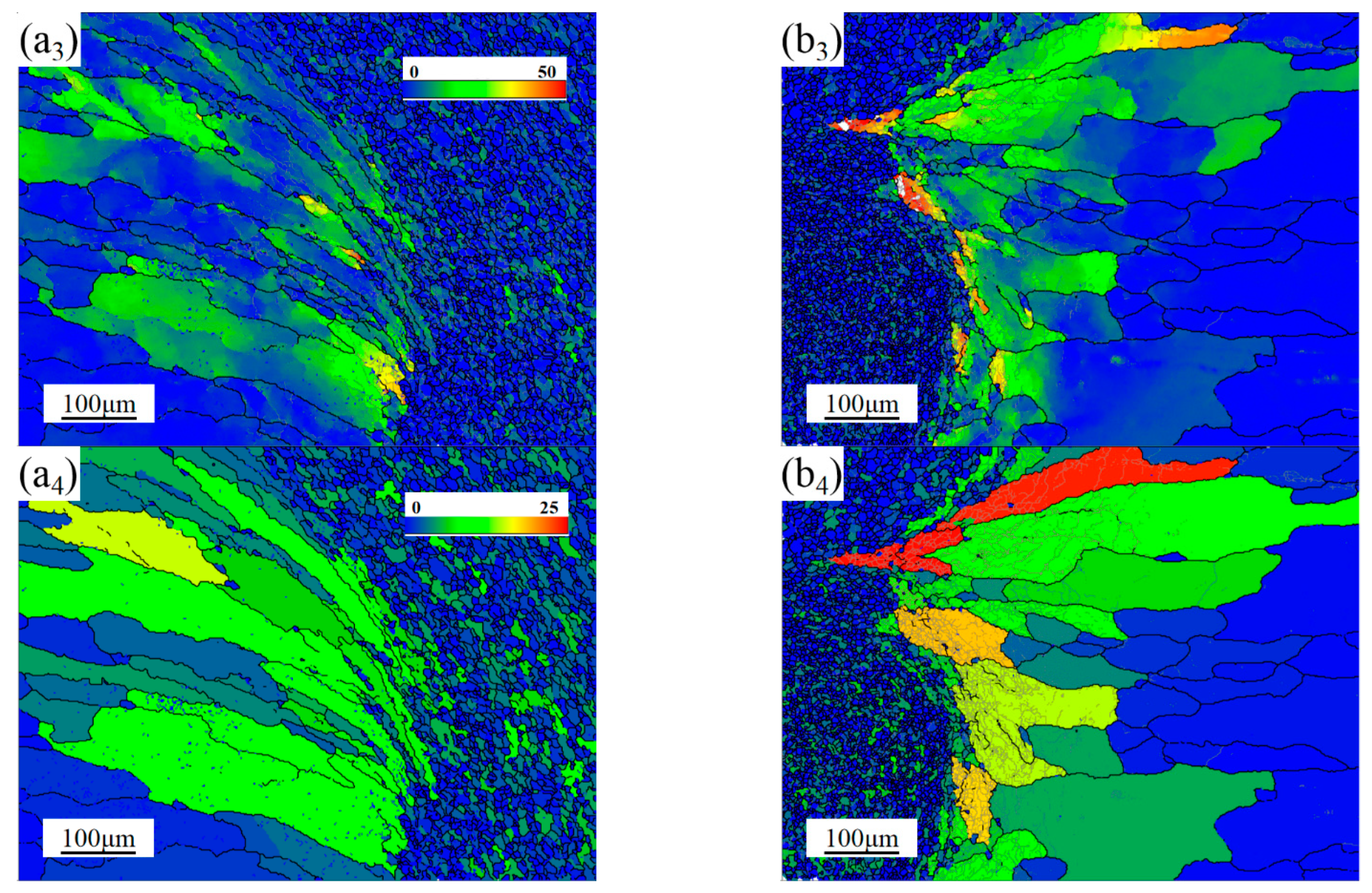
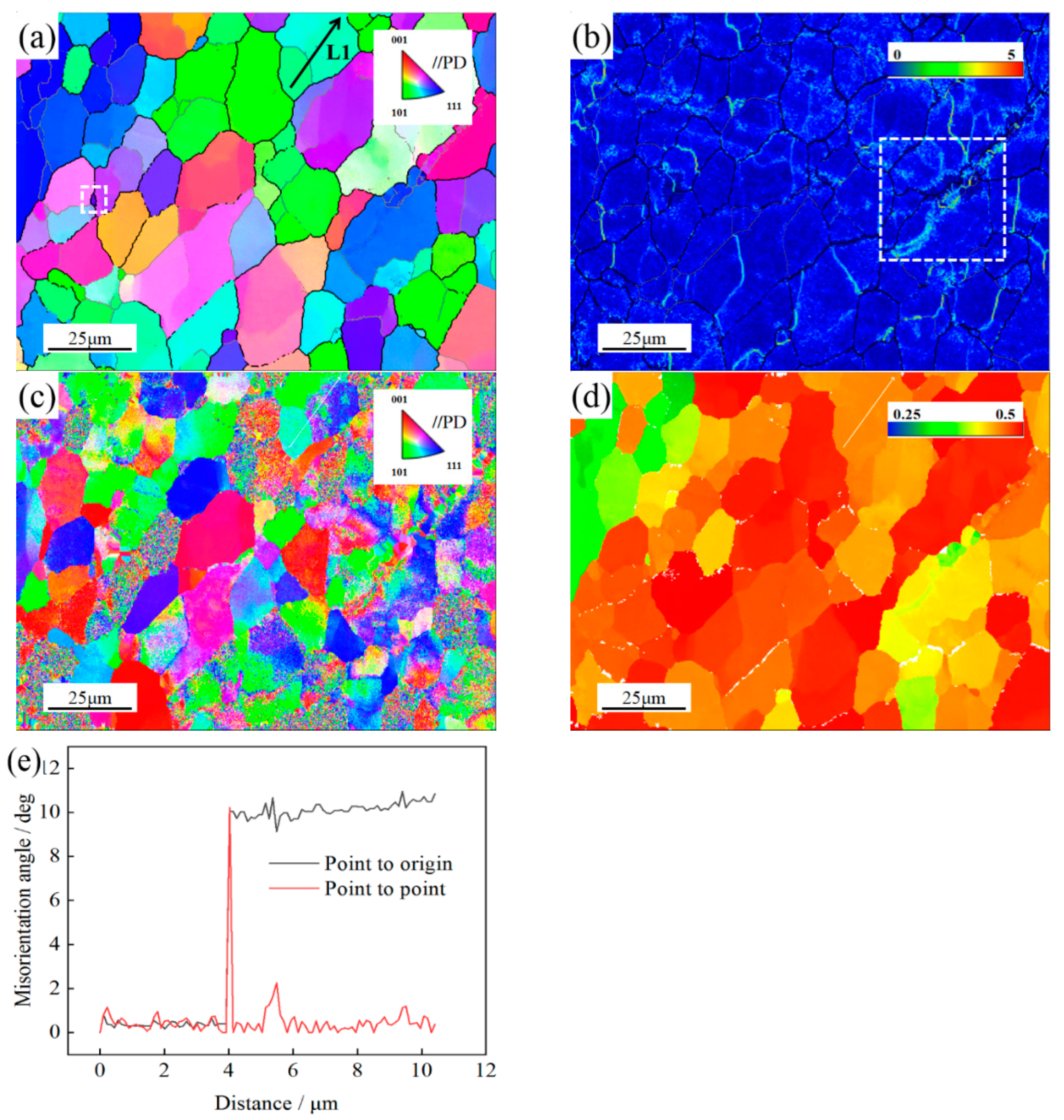
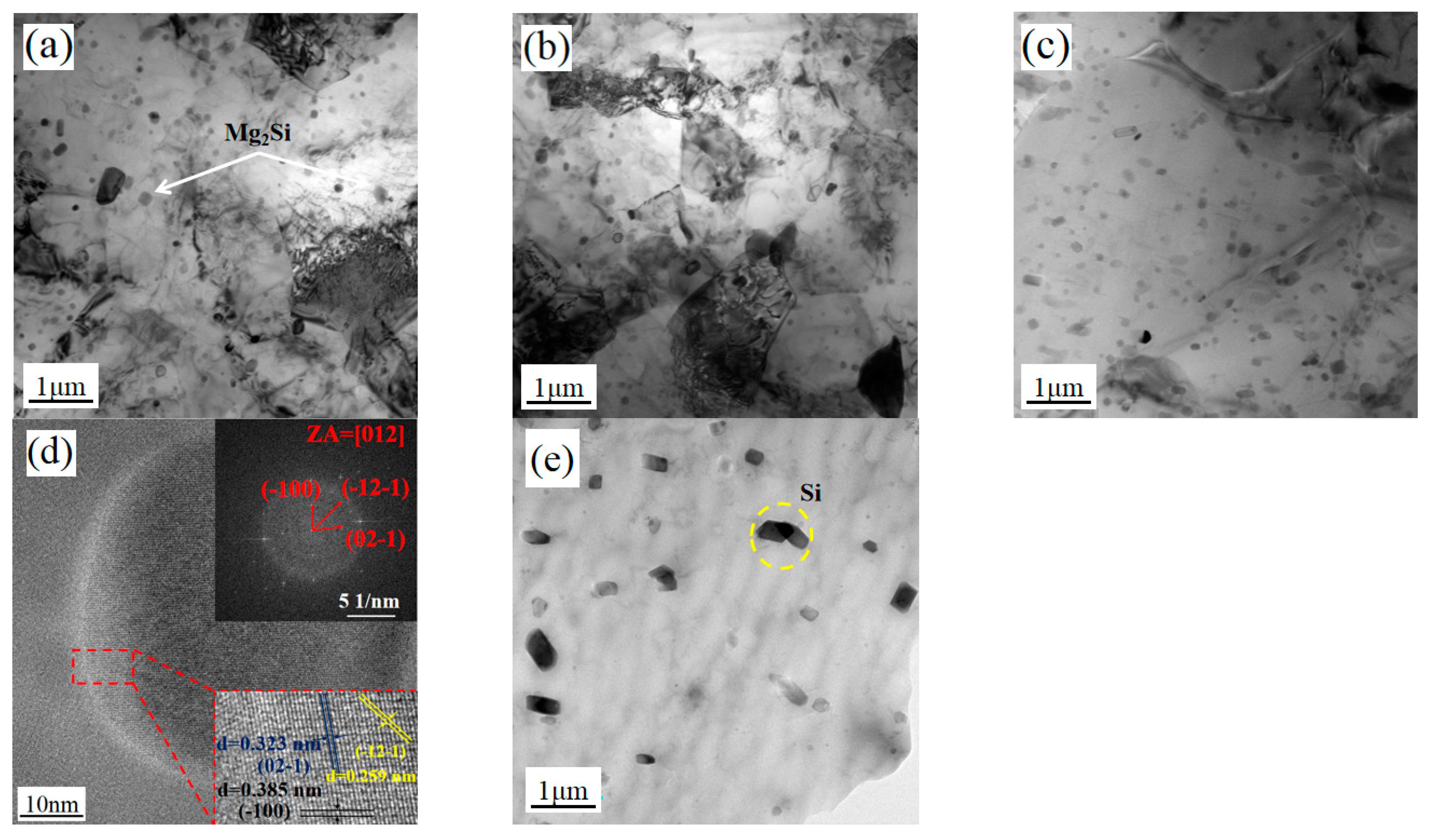
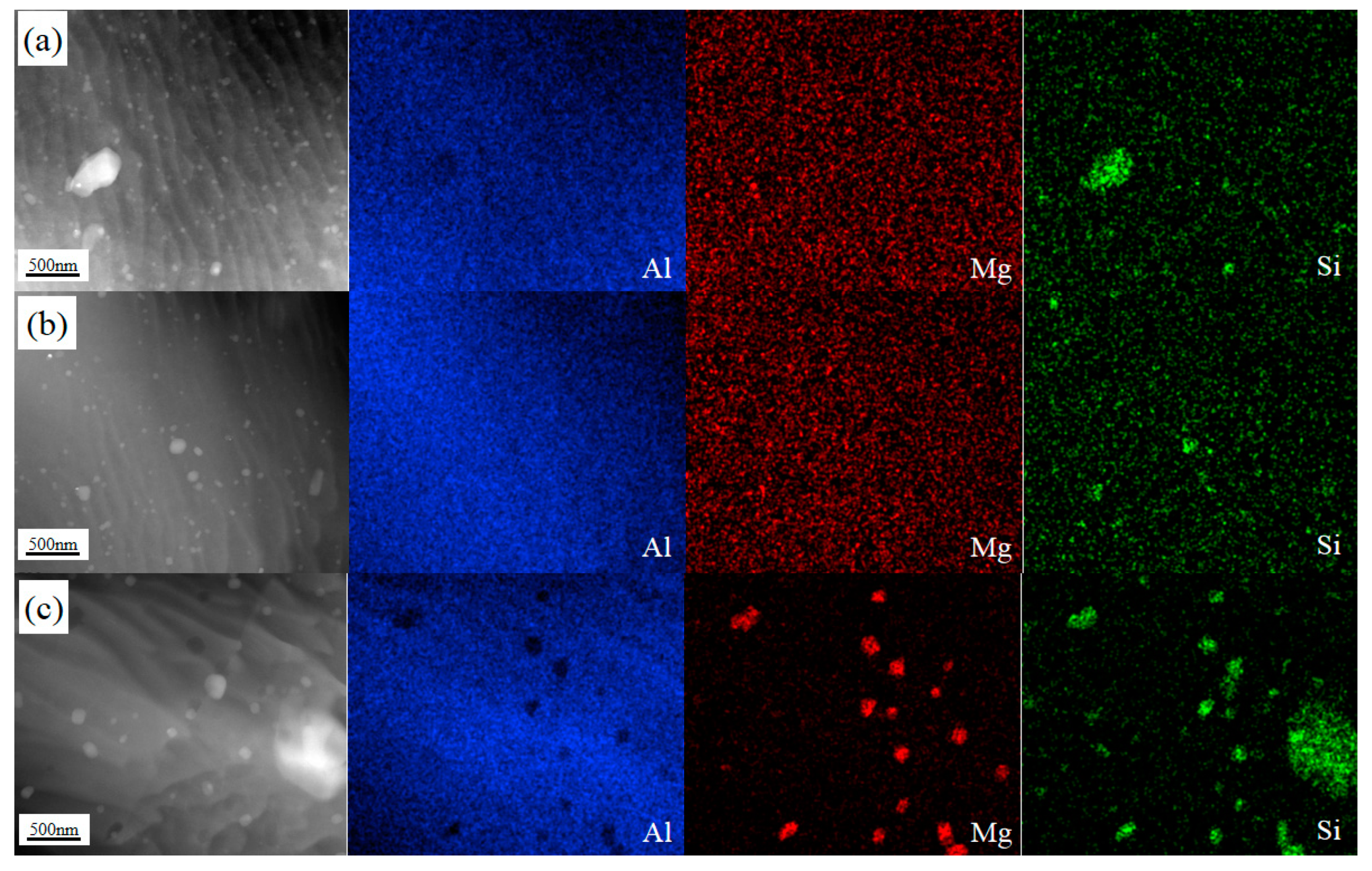
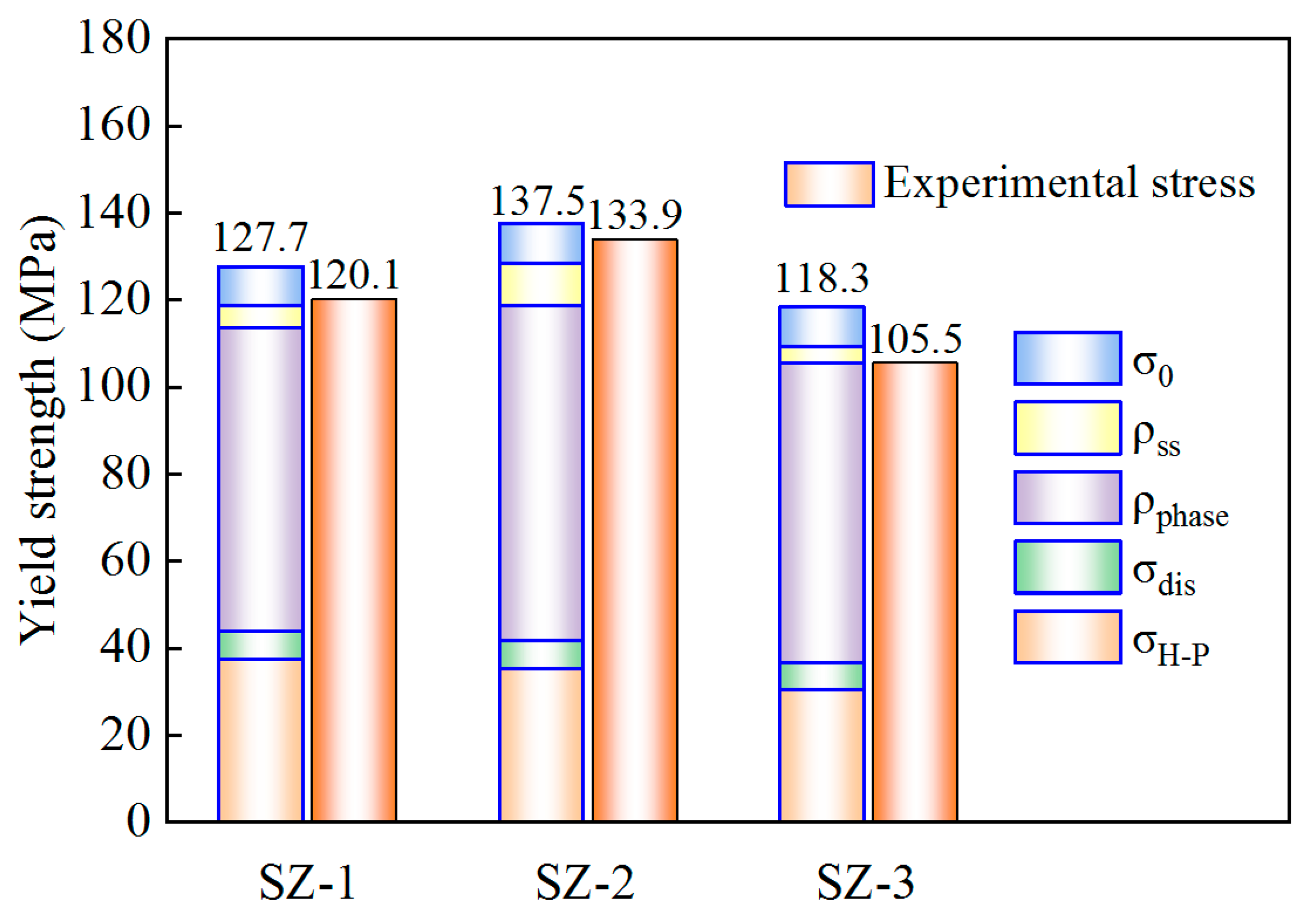
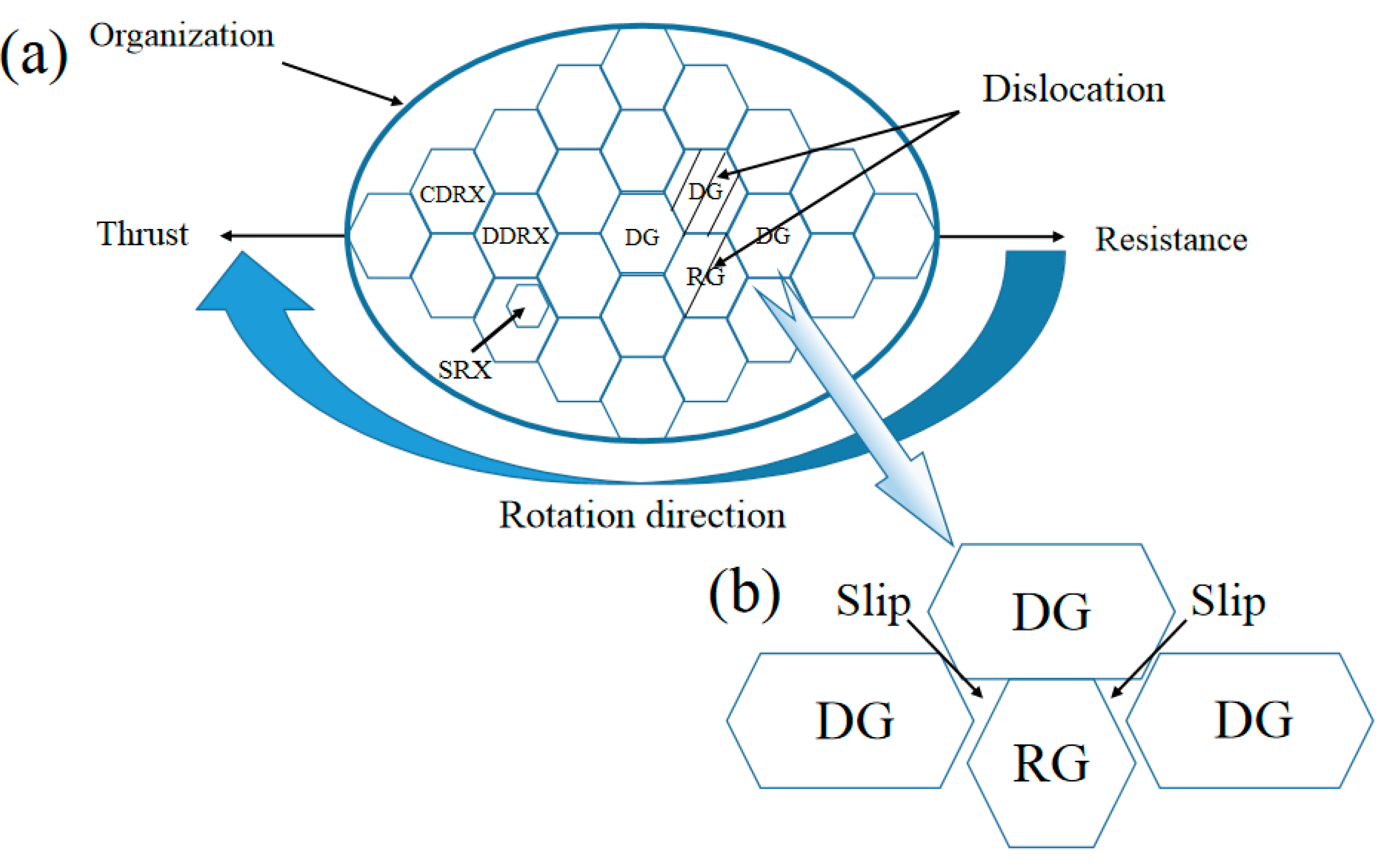
| Element | Mg | Si | Fe | Mn | Cu | Al |
|---|---|---|---|---|---|---|
| content | 1.16 | 0.66 | 0.4 | 0.2 | 0.22 | Bal. |
| Location | ψ1 | Φ | ψ2 | Number Fraction | Taylor Factor |
|---|---|---|---|---|---|
| SZ-1 | 0° | 0° | 0° | 0.032 | 2.813 |
| 35° | 45° | 0° | 0.083 | ||
| 90° | 35° | 45° | 0.007 | ||
| 0° | 45° | 0° | 0.019 | ||
| SZ-2 | 0° | 0° | 0° | 0.045 | 2.933 |
| 35° | 45° | 0° | 0.030 | ||
| 90° | 35° | 45° | 0.048 | ||
| 0° | 45° | 0° | 0.044 | ||
| SZ-3 | 0° | 0° | 0° | 0.028 | 2.907 |
| 35° | 45° | 0° | 0.021 | ||
| 90° | 35° | 45° | 0.084 | ||
| 0° | 45° | 0° | 0.024 |
Disclaimer/Publisher’s Note: The statements, opinions and data contained in all publications are solely those of the individual author(s) and contributor(s) and not of MDPI and/or the editor(s). MDPI and/or the editor(s) disclaim responsibility for any injury to people or property resulting from any ideas, methods, instructions or products referred to in the content. |
© 2023 by the authors. Licensee MDPI, Basel, Switzerland. This article is an open access article distributed under the terms and conditions of the Creative Commons Attribution (CC BY) license (https://creativecommons.org/licenses/by/4.0/).
Share and Cite
Peng, Y.; Xie, Z.; Su, C.; Zhong, Y.; Tao, Z.; Zhuang, D.; Zeng, J.; Tang, H.; Xu, Z. Inhomogeneous Microstructure Evolution of 6061 Aluminum Alloyat High Rotating Speed Submerged Friction Stir Processing. Materials 2023, 16, 579. https://doi.org/10.3390/ma16020579
Peng Y, Xie Z, Su C, Zhong Y, Tao Z, Zhuang D, Zeng J, Tang H, Xu Z. Inhomogeneous Microstructure Evolution of 6061 Aluminum Alloyat High Rotating Speed Submerged Friction Stir Processing. Materials. 2023; 16(2):579. https://doi.org/10.3390/ma16020579
Chicago/Turabian StylePeng, Yuchen, Zonghua Xie, Changchao Su, Yuefang Zhong, Zushan Tao, Dongyang Zhuang, Jiahui Zeng, Hongqun Tang, and Zhengbing Xu. 2023. "Inhomogeneous Microstructure Evolution of 6061 Aluminum Alloyat High Rotating Speed Submerged Friction Stir Processing" Materials 16, no. 2: 579. https://doi.org/10.3390/ma16020579
APA StylePeng, Y., Xie, Z., Su, C., Zhong, Y., Tao, Z., Zhuang, D., Zeng, J., Tang, H., & Xu, Z. (2023). Inhomogeneous Microstructure Evolution of 6061 Aluminum Alloyat High Rotating Speed Submerged Friction Stir Processing. Materials, 16(2), 579. https://doi.org/10.3390/ma16020579






